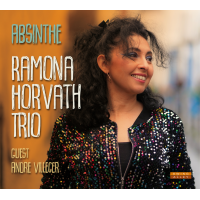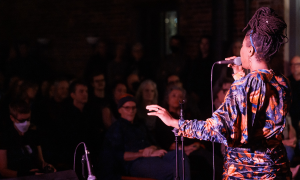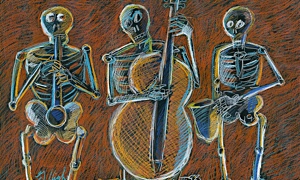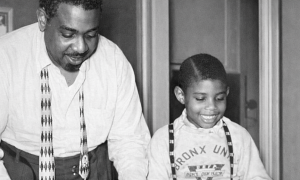Home » Jazz Articles » What is Jazz? » The Touch of Your Lips: The Colors of Jazz Piano
The Touch of Your Lips: The Colors of Jazz Piano

Technique is a matter of training the fingertips to attack and leave the keys under the absolute discipline of the brain. Touch has a much broader and wider significance. It is touch that reveals the soul of the player.
—Ossip Gabrilowitsch, concert pianist/conductor (and Mark Twain's son-in-law)
The idea that pianists are able to create different tone colors and different timbres, was once a topic of heated debate, but is now no longer questioned. For some performers, the sound can be a musical identifier on par with a fingerprint, which is a strong argument for their ability to coax a wide array of tone colors from what is, essentially, a fairly monochromatic instrument. On a percussion instrument like the piano, the range of tone color is severely limited in comparison, say, to a brass instrument like the trumpet or the saxophone. In the case of the trumpet, the player's lips are the source of the sound. The lips and everything behind them (teeth, oral cavity, throat), can be many different shapes and sizes, and all of those physical attributes will affect the sound. Players can also choose from an almost infinite number of different mouthpieces and instruments with different dimensions that help them forge their own unique sound. However, on the piano, the sound is made by a hammer hitting a string, and thus the player's body and its physical attributes are far removed from the creation of the sound.
So, how is it possible for a pianist to create a unique sound with a variety of colors and timbres? When we talk about this, we use the term "touch," which means that the way the pianist is hitting the keys, his/her "touch," is creating an individual sound that is described as being warm, crisp, rich, dark or a host of other descriptive adjectives. Is there such a thing as "touch" that results in the production of tone color on the instrument? This question has perplexed and beguiled musicians and acousticians since the keyboard was invented, and the answer was, and perhaps still is depending on who you ask, mysterious and almost preternatural, somewhere in the twilight zone between "fact and fantasy."2
Part I: A Brief History of Keyboard Technique and Touch
To begin with, we should remember that the first keyboard instruments were not standardized, so builders of organs, clavichords, harpsichords, and later, pianos, were inventors who experimented with different designs, often receiving input from performers on sound quality and playability. One of the performers' biggest concerns was regarding the perceived "weight" of the keys and the length of the keystroke. From the letters of the clavichord builders in the time of J.S. Bach, we find consistent requests for a "light touch" to make it more comfortable to play.3 Of course, a pedagogy followed, one that included the correct position of the fingers, disposition of the wrist and forearm, and arm weight (generally avoided for organs, clavichords, and harpsichords). 4 Once the piano is invented in the early 1700s, we suddenly have an instrument that has a greatly expanded dynamic range (its full name is "pianoforte" or "soft-loud"!). Because of that, a new pedagogy emerges that includes elements of the previous keyboard techniques, but is also markedly different, as described by Alexandra Mullen:The piano itself could now generate a greater range of effects, shimmering timbres, singing legatos, striking brilliance. Technically, piano-playing began to shift from the digital emphasis growing out of light-actioned clavichords and harpsichords to working with the strength and flexibility of full arms and even back.5
Thus, the exploration of the piano's sonic capabilities became a defining feature of 19C piano music. This mirrored what was happening in orchestral music as well. Classical composers in the 19C treated tone color as an essential component of their music, whereas previously, they did not; Bach and Mozart were certainly aware and mindful of tone color, but its exploration was not one of their primary concerns.
In the 19C, tone color emerges as a musical device that stands almost on equal footing with melody and harmony. For pianists, this means that developing "touch" (among other coloristic techniques accessed through the use of the three pedals) is mandatory, and the best of the best appeared to have almost supernatural abilities to shade and color their tone almost as if they were sound painters. As this review of a concert played in England by Franz Liszt in 1841 shows, the pianist's ability to dazzle with overwhelming power and sound is highly valued:
...it is only when some comet, some giant, some tiger-tamer, some new Niagara, some winged being...appears, that our obdurate faculties are roused into the consciousness that miracles do exist. Of the miracle genus is [Franz] Liszt, the Polyphemus of the pianoforte—the Aurora Borealis of musical effulgence—the Niagara of thundering harmonies! His rapidity of execution, his power, his delicacy, his Briareus-handed6 chords, and the extraordinary volume of sound he wrests from the instrument, are each and philosophies in their way that might well puzzle all but a philosopher to unriddle and explain. 7
Increased volume and overall power were on one side of the spectrum, and sublime sensitivity and delicacy were on the other, as Hector Berlioz's description of Chopin's playing shows:
There are incredible details in his mazurkas, and he has found how to make them doubly interesting by playing them with the utmost degree of gentleness, with a superlative softness. The hammers just graze the strings so that the hearer is tempted to draw near the instrument and strain his ear, as though he were at a concert of sylphs and will-o'-the wisps.8
While musicians in the 18C commonly used "touch" 9 regarding the proper way for fingers to depress the keys, it eventually emerged as the chosen term of critics and musicians alike to describe the pianist's ability to create tone color on the instrument. Here is a description of Ignacy Paderewski's10 playing from 1892:
He mirrors his Slavonic nature in his interpretations, with its fine and exquisite appreciation of all gradations of tonal effect. His marvelously musical touch, a great, mellow, and tender voice, chameleon-like, takes on the color of his dominant mood...His never-failing warmth of touch and his vivid appreciation of tone gradations and values result in wonderfully beautiful effects...Paderewski's playing, which is at times orchestral in its sonority, the most violent extremes of color being present...ask what pianist since Liszt has given us such gorgeous, glowing colors—such explosions of tone... 11
While the language is less hyperbolic and fanciful, these kinds of descriptions are found throughout the 20C and to the present day, where tone color and timbre, are, for every instrumentalist and composer, primary musical elements that must be recognized as such. As classical music developed, composers and instrumentalists searched for new ways to expand their expressive capabilities. Eventually, after counterpoint, melody, and harmony had been fully mined, they turned to other elements (like tone color) to provide variation.
Is Touch Real?
We now return to the original question: if pianists can somehow develop unique timbres and tone colors, how do they do that? Once the key is depressed, the hammer's movement to the strings is underway, and the pianist has no more influence on the tone produced. (Certainly pedaling is a means of changing tone color, but that is a separate discussion outside of the realm of pure touch.) Here is a description of the process from William Braid White, who conducted one of the first scientific inquiries into the phenomenon of touch in 1929:...the musician can exert no control over a sound produced by him through the key and "action," at any time after the immediately-rebounding hammer stroke has been delivered. During that portion of his manipulation of the key which precedes the stroke of the hammer, the musician can depress the key: a) with constant velocity, b) with velocity increasing as the key comes down, or c) with velocity decreasing during downward travel...It is evident, then, that the musician can cause the hammer to travel towards the string at any one of many possible velocities, and that the velocity of the hammer at the moment of its contact with the string is the one factor in production of tone that musicians can control.12
Given the physical reality, how can one pianist sound different than another on the same instrument?
This was a hot topic in the early part of the 20C, and of course, pianists also weighed in on this, sometimes with humorous results. Karl Leimer, a contemporary of the famous German pianist, Walter Gieseking, references a touch that is: "produced by soft pressure, the first condition being that the finger does not leave the key at all..." With this touch, Leimer says that the pianist can "render the finest and most delicate shadings. Gieseking's so richly colored rendering of impressionistic music...which is regarded by musicians and critics all over the world as unexcelled, is due to...this style of touch." 13 Gieseking, on the other hand, appears to be in disagreement with his co-author: "It is useless to look for the reason of the beautiful tone in some particular finger position or hand positions; I am convinced that the only way to learn to produce beautiful tone is systematic ear training." 14
Here's the famous Russian concert pianist Josef Lhevinne (1874-1944) explaining how to produce a "lovely, ringing, singing" tone:
...through hearing intimately most of the great pianists, from Rubinstein to the present, certain basic facts seem to be associated with those who have good tone in contrast to those who do not.... In the previous section, we have spoken of the part of the finger that comes in contact with the keys. If that part is well covered with cushions of flesh, the tone is likely to be far better than if it were hard and bony. Therefore, the main principle at the first is to see that the key is touched with as resilient a portion of the finger as possible, if a lovely, ringing, singing tone is desired instead of a hard, metallic one. 15
Fat fingers make for a "lovely, ringing, singing" tone, while skinny fingers produce a "hard, metallic" tone—got it! It's easy to laugh about this, but the question is serious, even if the answers always aren't. There have been, as referenced previously, scientific investigations by acousticians. White's study recruited some of the finest pianists of the era, including Vladimir Horowitz, Josef Lhevinne, Rudolph Ganz, Carolyn Beebe, Olga Samaroff, and others to take part in the investigation. White had them all play a single note on the piano, without pedal, at as many different volumes as they could produce. He recorded them and measured the volume, as shown by wave amplitude. (One of the pianists, Mischa Levitski, played the note 21 times, and remarkably achieved 18 different volumes!)
Others studied the issue using different means. In 1934, a more sophisticated study by Hart, Fuller, and Lusby, was carried out using a "mechanical striker" (See Figure 1 in the slideshow above.) to play the notes, which produced a larger number of different volumes than even the concert pianists could.
They used a car headlight (!) to shine light through a piece of cardboard with slits in it which was attached to the hammer mechanism in a Steinway piano. (They had to remove 50 hammers to install the optical system. See Figure 2 in the slideshow above.) They then recorded the hammer's velocity and acceleration using "light traces," which were projected onto a film on the other side of the hammer. This provided them with a visual representation (a "photographic record") of "hammer displacement" at different hammer velocities. They also had concert pianists play the note, and they compared that to the mechanical striker and to amateurs playing the note. Surprisingly, (or unsurprisingly, depending on which side of this debate you're on), they found no differences in wave amplitude (and thus sound quality) when all three struck the key with the same velocity.
They posited that the length of time that the hammer was in contact with the string would change the tone, and perhaps that was something the pianist could control, but they found no evidence of that variable being present.
Their conclusions supported other studies16 (with different methodologies) and those of White (quoted below):
...what the pianist may describe as a wrist movement, as opposed to an arm or finger movement directed at the key, may have virtues of its own as a producer of tone from the piano; but it is necessary to remember that this is simply another way of saying that he has learned how to impart various velocities to the hammers of the piano. He may find it hard to believe that all these reduce themselves to so many elaborate devices for controlling hammer velocity, that is to say loudness of sound; yet it should be sufficient consolation to him to be able to say, as he may, that each difference of loudness involves a difference, however slight yet distinct, of tone-color. Thus the operation of producing tone from the piano aims, for its primary objective, at control of one factor only, namely hammer-velocity, or in other words of string amplitude; or again in other words, of loudness.
Absent pedaling, the only element that a pianist can control in regards to the tone the instrument makes is the velocity of the hammers, a realization that is, at first glance, somewhat dismal and cold—is that all there is to it? Yes, but this clinical and somewhat terse answer to an impossibly complex question belies the overwhelming complexity of what the pianist does in controlling his/her tone color. These tests involved the playing of one single note, which is not what pianists generally do (unless playing the pulse note in a minimalist piece). Pianists are called on to play tens of thousands of notes in a large piece like a Brahms piano concerto, most of which include large (6-8 notes) and small (4-6 notes) chords. The tone color/volume of each note in each chord must be carefully chosen to ensure that the melody (which could be in the top note of the chord, the middle, or the bottom) is louder than the rest. This means that each finger, as it takes over the melody, must duplicate the velocity of the previous finger, all of which happens in microseconds. All of the other fingers must control their volume in turn. And not all of these are the same volume —the very best pianists can control each pitch's volume to tailor the overall sound to their tastes. This is why, despite the monochromatic result of these tests, the best pianists are able to elicit the kinds of flowery descriptions and breathless praise that was referenced earlier. What we are hearing is, in reality, a stunning display of technical skills that provide us with an almost limitless array of tone colors based on the careful manipulation of the volume of tens of thousands of notes. Pianists make those calibrations intuitively based on the type of sound desired, and with so many possible choices given the number of pitches, the potential for developing an individual sound is enormous.17
The tests also avoided the fancy footwork going on under the piano with the sustain pedal and the una corda. The sustain pedal is used constantly by pianists to control the volume and create a myriad of coloristic effects. The control of the sustain pedal by the right foot is much more sophisticated than it might at first seem. My esteemed classical piano teacher, the late Danielle Martin, who was a student of Leon Fleisher's, told me that a pianist should strive for at least 24 different levels of pedal depression. Remarkably, she claimed that there were over 100 available! Keep in mind that the pedal only moves about three inches, so the foot needs to access eight different points in each inch in order to meet the minimum requirement of 24 pedal positions. The sustain pedal is thus far from a simple "on-off" switch, although that is how amateur pianists tend to use it. As with touch, the best pianists have exquisite and nuanced control of the pedals, and use them to help create their own unique sound and palette of tone colors.
The "soul" of the pianist, as a painter in sound, does indeed manifest itself in the concept of touch. Touch does seem the appropriate term to use because it reflects the emotional and physical intimacy of the pianist's relationship with the instrument. It does so in a way that is authentic and descriptively rich enough to account for the different sounds and tone colors created by the great classical pianists from the 19C to the present day. Classical music is not the only genre where touch plays a major role; it has become just as important for jazz pianists, where its development followed a similar trajectory.
Part I serves as an introduction to the history of touch on keyboard instruments in general and on the piano in particular (which was entirely in the classical realm). Part II and III will investigate the history of touch in jazz piano, an element that is largely overlooked, but which played a major role in the development of jazz piano.
ENDNOTES
1 Gabrilowitsch, Ossip. "Essentials of Touch." Great Pianists on Piano Playing; Godowsky, Hofmann, Lhévinne, Paderewski and 24 Other Legendary Performers, by James Francis Cooke, Theo. Presser, 1917, pp. 122—130.2 "Touch and Tone: Fact and Fantasy." The Pianist's Problems: A Modern Approach to Efficient Practice and Musicianly Performance, by William S. Newman, Da Capo Press, 1986, pp. 115—121.
3 Crowell, G. (2014). Bach's Keyboard Technique and Its Implications for Clavichord Touch. In B. Darmstädter & I. Hohelsel (Eds.), Unisonus: Musikinstrumente erforschen, bewahren, sammeln (pp. 104- -105). Vienna: Praesens Verlag.
4 Crowell, G. (pp. 99—100).
5 Mullen, Alexandra. (2004). In Search of Chopin. The Hudson Review, 56(4), 697. doi:10.2307/3852970
6 Briareus was a Greek god, one of three giants who had 50 heads and 100 hands.
7 Liszt iṇ England. (1902). The Musical Times and Singing Class Circular, 43(710), 230-233. doi:10.2307/3369694
8 Mullen, A. (2004). In Search of Chopin. The Hudson Review, 56(4), 696. doi:10.2307/3852970
9 Pasquali, N. The Art of Fingering the Harpsichord; illustrated with examples in notes; to which is added, an approved method of tuning this instrument: by Nicolo Pasquali. Edinburgh, [1760?]. Eighteenth Century Collections Online. Gale. Grand Valley State University. 22 Mar. 2020
10 Ignacy Paderewski (1860-1941) was one of the most celebrated concert pianists of his time. He was also a successful statesman and patriot who served as the Prime Minister and Minister of Foreign Affairs of Poland during WW1, and Chief of the National Council of Poland during WW2.
11 Mason, W. (1892, March). Paderewski: A Critical Study. Century Illustrated Magazine, XLIII(5), 720—725.
12 White, W. B. (1929). Human Factor in Piano Tone Production. The Journal of the Acoustical Society of America, 1(1), 357 —358. doi: 10.1121/1.1901881
13 Gieseking, W., & Leimer, K. (1972). Piano technique. (pp. 22-23) New York: Dover Publications.
14 Gieseking, W. (1975). So wurde ich Pianist. Wiesbaden: F.A. Brockhaus. Referenced in Kochevitsky, G. (1967). The art of piano playing: a scientific approach. (p. 38) Evanston, IL: Summy-Birchard.
15 Lhevinne, J. (1972). Basic Principles in Pianoforte Playing. (p. 18) New York, NY: Dover Publications Inc.
16 Askenfelt, A., Galembo, A., & Cuddy, L. L. (1998). On the acoustics and psychology of piano touch and tone. The Journal of the Acoustical Society of America, 103(5), 2783. doi: 10.1121/1.421527
17 It is also useful as a pedagogical tool—asking a student to "play the six notes in that chord with the following different hammer velocities" would result in paralysis. However, if we use the language of touch, we present the player with a more conceptual approach that is imaginative and open to creative interpretation: "play that chord with a different touch—make it lush and warm, then bring out the top note and make it ring like a bell." This approach is far more likely to produce meaningful results.
SELECTED BIBLIOGRAPHY
- Fraser, Alan, and Sonya Ardan. Honing the Pianistic Self-Image: Skeletal-Based Piano Technique. Maple Grove Music Productions, 2010.
- Fraser, Alan. The Craft of Piano Playing: A New Approach to Piano Technique, Scarecrow Press, 2011.
- Friedberg, Ruth C. The Complete Pianist: Body, Mind, Synthesis. Scarecrow Press, 1993.
- Hofmann, Józef, and Gregor Benko. Piano Playing: with Piano Questions Answered. Dover Publications, Inc., 1976.
- Lhévinne, Josef. Basic Principles in Pianoforte Playing. University Microfilms International, 1981.
- Kochevitsky, George. The Art of Piano Playing: A Scientific Approach. Summy-Birchard Music, 1967.
- Matthay, Tobias. The Visible and Invisible in Pianoforte Technique. Oxford University Press, 1977.
- Timbrell, Charles. French Pianism: a Historical Perspective. PRO/AM Music Resources Inc., 1992.
Tags
PREVIOUS / NEXT
Support All About Jazz
 All About Jazz has been a pillar of jazz since 1995, championing it as an art form and, more importantly, supporting the musicians who make it. Our enduring commitment has made "AAJ" one of the most culturally important websites of its kind, read by hundreds of thousands of fans, musicians and industry figures every month.
All About Jazz has been a pillar of jazz since 1995, championing it as an art form and, more importantly, supporting the musicians who make it. Our enduring commitment has made "AAJ" one of the most culturally important websites of its kind, read by hundreds of thousands of fans, musicians and industry figures every month.






















